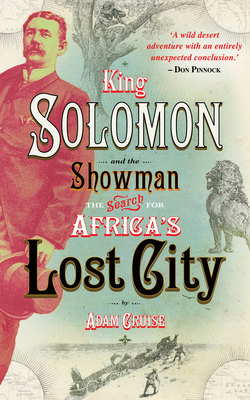Читать книгу King Solomon and the Showman - Adam Cruise - Страница 4
Chapter One
ОглавлениеLost
The track I was following eventually vanished completely in the tall yellow grass, and with some difficulty I turned the heavy truck around and headed back the way I had come. After a kilometre I found another track, branching off to the left. Though it was also indistinct, and I had no idea where it would take me, I swung the truck and began nosing my way cautiously along the new route. In the searing Kalahari temperatures my GPS had, once again, been fried where it was mounted on the windscreen of the vehicle. Without it, I had to rely on decades-old paper maps drawn by travellers who had, like myself, been foolhardy enough to enter this desert. The maps had seemed reliable enough – until I realised that each presented its own idiosyncratic version of the arid terrain I faced. One told me to look for a turnoff from a dry riverbed at the point where there was a large camelthorn tree. This would be helpful anywhere but the Kalahari, where every dry riverbed is punctuated along its entire length by large camelthorn trees.
However, I knew that the new track was heading roughly north, and north was the general direction I wanted to go. Late that afternoon, I ruptured a tyre on a sharp branch half-buried in the sand. By the time the tyre was repaired, a bank of thunderclouds had rumbled past without breaking. Only a few heavy drops fell, making a sound like lead shot on the bonnet of the truck. I continued driving for another half hour until the sky softened to the pastel violet of dusk, then eased my foot off the accelerator and allowed the sand to bring the truck to a slow halt in a dense thicket of tall trees. With night approaching fast, there was just time to pitch my tent and gather a heap of dry wood. I lit a large fire to keep away the nocturnal predators who had already begun to yip, cackle and roar; then threw some rice and tinned vegetables into a pot. I poured the evening’s obligatory glass of warm wine, leaned back against a twisted log and watched the furnace-red sun sink behind the long grassy ridge of a dune.
Oh well, I thought, I may be lost, but I am precisely where I want to be.
The reason I was in the Kalahari had its roots in a paper delivered to the Berlin Geographical Society on 7 November 1885. The presenter, Gilarmi Antonio Farini, had three months earlier completed what he claimed was an epic journey through southern Africa. Though the paper described a new route into uncharted territory, and the indigenous people encountered along the way, its main and rather prosaic objective was to discuss the feasibility of cattle ranching in the southwest corner of the Kalahari Desert. The author found the area favourable for such an endeavour, despite the waterless nature of the landscape. However, his audiences, both in Berlin and at a similar presentation the following year to the Royal Geographical Society in London, remained single-mindedly unconvinced. As far as the venerable gentlemen were concerned, the explorer’s foray into the Kalahari was a substandard expedition, and nothing new had been discovered – or at least nothing to tempt further consideration. The proposal to turn the area into a second Texas for cattle ranchers was mothballed for good.
Farini would have disappeared into anonymity – at least as an explorer – if it were not for this passage dropped, almost as an afterthought, into the middle of his paper:
While hunting we came across an irregular pile of stones that seemed in places to assume the shape of a wall, and on closer examination we traced what had evidently once been a huge walled enclosure, elliptical in form and about the eighth of a mile in length. The masonry was of a cyclopean character; here and there the gigantic square blocks still stood on each other, and in one instance the middle stone being of a softer nature was weatherworn. A large stone, about six feet in length and the same in width, was balancing on this, and but for its great inertia would have been blown over by the wind. Near the base of the ruined walls were oval shaped rocks, hollowed out, some composed of one solid stone and others of several pieces joined together. These peculiar basin-shaped ovals were regularly distributed every few yards around the entire ellipse. In the middle was a kind of pavement of long narrow square blocks neatly fitted together, forming a cross, in the centre of which was what seemed to be a base for either a pedestal or monument. We unearthed a broken column, a part of which was in a fair state of preservation, the four flat sides being fluted. We searched diligently for inscriptions, but could find none, and hence could collect no definite evidence as to the age and nature of the structure.
That was the first-ever mention of the Lost City of the Kalahari.
